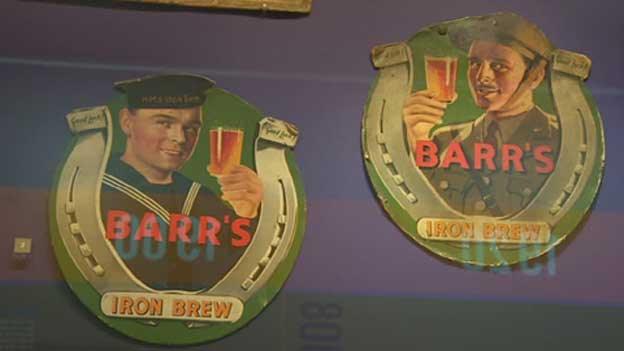Irn Bru bottles reach point of no return
- Published

Glass Irn Bru bottles have become less common in recent years
Returnable glass bottles are an unlikely national icon but their demise has unleashed a lot of nostalgia for the soft drinks that fuelled many Scottish childhoods.
"It's a sad decision to take," admits AG Barr's commercial director, Jonathan Kemp. "It's the end of an era."
Irn Bru, made by AG Barr, may dominate Scottish sales now, in a battle for supremacy with Coca-Cola, but it wasn't always that way.
Other names were on the horse drays and flat-bed trucks bringing wooden crates of bottles to corner shops and for doorstep deliveries, as with milk. In Aberdeen, it was Bon Accord. In Edinburgh, it was James Dunbar.
A gentlemen's agreement between Scotland's fizzy pop barons meant that they kept off each other's turf, at least until the 1970s, when the smaller, weaker firms began to go under, or to be bought up by the AG Barr family firm.
It had trademarked 'Irn Bru', while others sold Iron Brew and their own Cola, or Kola. And with a heavy, imaginative marketing spend, it established itself as a national icon.
This consolidation grew from the 19th century market, which had been shaped by the distance a horse can haul a load of bottles in a day. That was 10 miles out from the factory, and ten miles back, so the country had soft drinks plants roughly 20 miles apart.

Irn Bru has a history of producing teh drink in glass bottles
It was in 1996 that AG Barr built its plant in Cumbernauld. And while others had moved from glass to plastic and aluminium, the company installed a glass bottling line.
This continued a line going back to the company's founding in 1875, when all its drinks were in glass bottles. They were routinely returned, but without a deposit.
In 1905, four years after Barr's began making its Iron Brew (it became Irn Bru in 1947), the west of Scotland trade association adopted a deposit of half an old penny.
The industry began to adopt aluminium cans in the 1960s and plastic in the 1970s. Yet for Barr's, as it became national, returnable glass reached its peak in the 1980s, representing half its market in about 100m bottles.
So too in other markets around Britain. But the demise of returnable bottles was slower in Scotland than in England.

Irn Bru changed its named from Iron Brew after the war
And according to Jonathan Kemp: "I believe we are the last manufacturer with returnable glass bottles in Britain, although a few are imported, and I believe there's one line left in Northern Ireland."
When it moved into its Cumbernauld plant, bottles had fallen to less than 60m bottles. Around 90% were returned.
We're now down to 10m or so, and only half are returned. Even when the deposit went up from 20p to 30p in 2008, it didn't make much difference to the return rate. And from 2012, when legislation required a kerb-side collection of glass for re-cycling, the returns plummeted.
The bottle remains an icon. Having helped shipyard workers with the energy they needed, it's still often associated with drinking at the workplace, and often bought chilled.
Although working, buying and drinking habits change, investment in a new bottling line will keep it on the shelves for perhaps another 20 years. A more likely change before then for the £14bn soft drinks industry is to reduce the sugar content. One can of Irn Bru gives you 38% of your recommended daily intake.
As for the packaging: "A lot of people will tell you 'ginger' tastes best in glass, and there is science behind that," says the company's commercial director.
"In plastic, some carbon dioxide will escape, but not from glass, so there may be more fizziness in a glass bottle."